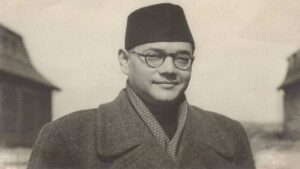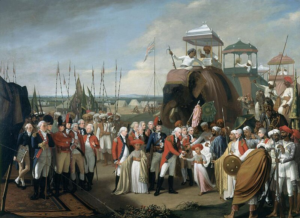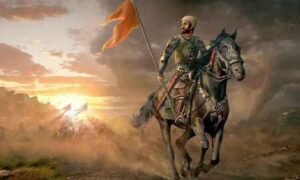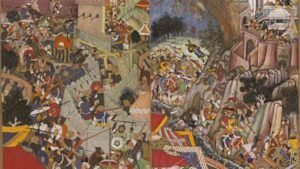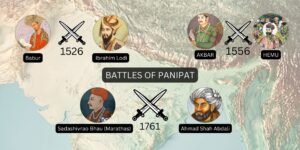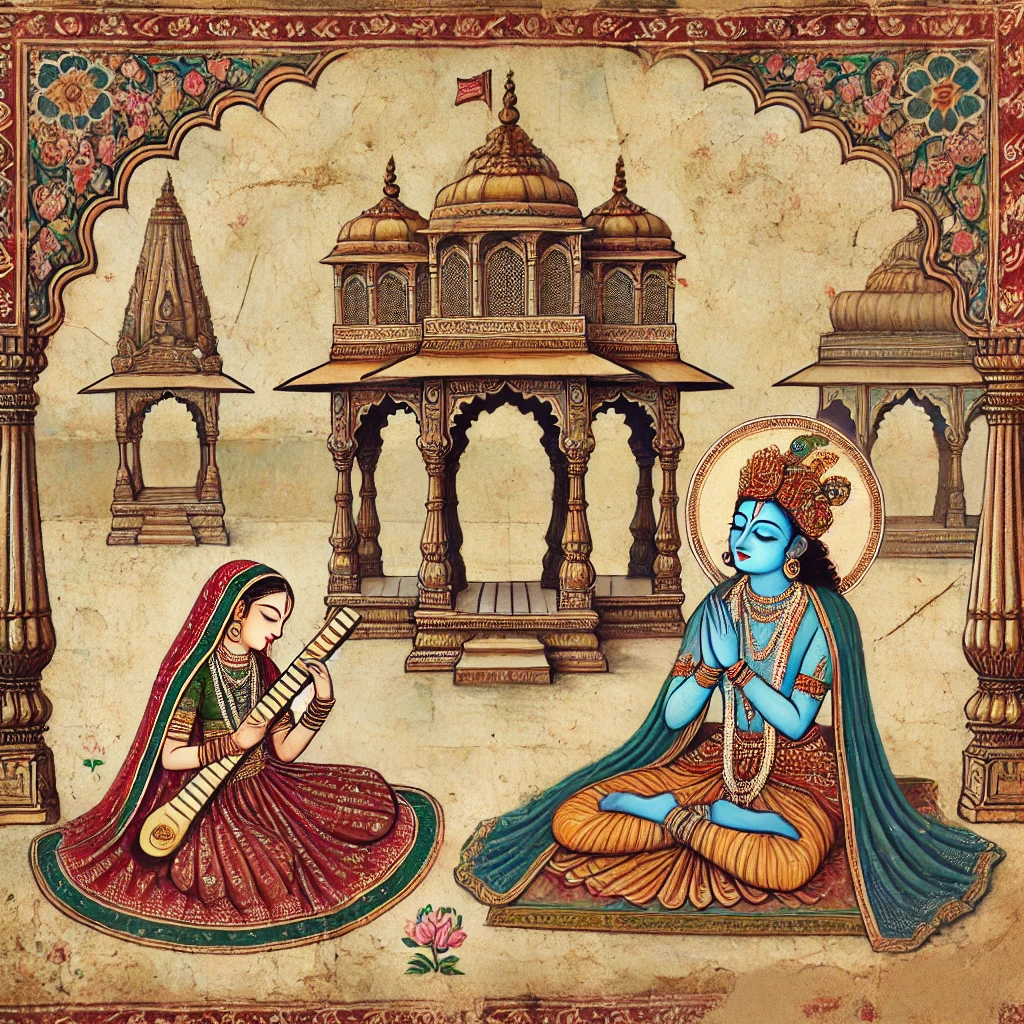
Between the 7th and 10th centuries CE, India witnessed the rise of the Bhakti movement, a significant socio-religious transformation that reshaped Hinduism and left an indelible impact on Indian culture. Bhakti, derived from the Sanskrit word meaning “devotion,” emphasized personal devotion to a deity over ritualistic practices. This movement democratized religious practices and promoted a direct relationship between the devotee and God, challenging established norms of caste and priestly hierarchy.
This article explores the origins, key figures, and contributions of the Bhakti movement in early medieval India, with a particular focus on the Alvars and Nayanars, who were instrumental in shaping this movement in Tamil Nadu.
Historical Context
Religious and Social Background
The early medieval period was marked by the rise of temple-centric Hinduism and the consolidation of Shaivism and Vaishnavism as dominant religious traditions. While Brahminical rituals and Vedic practices retained their influence, there was growing discontent among common people due to the exclusivity of these practices. The Bhakti movement emerged as a response to this exclusivity, offering an alternative path to spiritual fulfillment.
Influence of Tamil Culture
In South India, the Bhakti movement found fertile ground in Tamil Nadu. Tamil culture, with its rich poetic tradition and emphasis on emotional expression, played a crucial role in shaping Bhakti ideals. The movement also drew inspiration from earlier traditions, such as the Sangam literature, which celebrated love and devotion.
Key Features of the Bhakti Movement
- Personal Devotion to a Deity: Bhakti emphasized a deep, personal relationship with a chosen deity, often expressed through poetry, music, and dance.
- Rejection of Ritualism: The movement downplayed the importance of elaborate rituals and priestly mediation, focusing instead on sincere devotion.
- Inclusivity: The Bhakti movement welcomed people from all castes, genders, and social backgrounds, challenging the rigid hierarchy of the caste system.
- Vernacular Expression: Devotees used local languages, such as Tamil, Kannada, and Telugu, to compose devotional hymns, making religion more accessible to the masses.
The Alvars and Nayanars: Pioneers of the Bhakti Movement
The Alvars: Devotees of Vishnu
The Alvars were Tamil poet-saints devoted to Lord Vishnu, active between the 6th and 9th centuries CE. They composed hymns in praise of Vishnu, collectively known as the Divya Prabandham, which is regarded as a sacred text in Tamil Vaishnavism.
Key Figures:
- Andal: The only female Alvar, Andal composed Tiruppavai and Nachiyar Tirumozhi, expressing her intense devotion to Vishnu.
- Nammalvar: Considered the greatest of the Alvars, his hymns encapsulated profound philosophical and devotional insights.
Themes in Alvar Hymns:
- Unwavering love for Vishnu.
- The longing of the soul for union with God.
- Descriptions of Vishnu’s various forms and divine play (lilas).
The Nayanars: Devotees of Shiva
The Nayanars were Tamil poet-saints devoted to Lord Shiva. Their hymns, collectively known as the Tirumurai, form the foundation of Tamil Shaivism.
Key Figures:
- Appar (Tirunavukkarasar): Known for his deep philosophical hymns, Appar converted from Jainism to Shaivism.
- Sambandar: A child prodigy, Sambandar composed hymns celebrating Shiva’s grace and protection.
- Sundarar: A devotee who composed hymns that combined deep devotion with personal anecdotes.
Themes in Nayanar Hymns:
- Unconditional love for Shiva.
- The beauty of temples and sacred sites.
- The rejection of materialism and ego.
Philosophical Underpinnings
While the Bhakti movement was distinct in its focus on devotion, it was influenced by philosophical ideas like Advaita Vedanta, which emphasized the unity of the soul (atman) and the supreme reality (Brahman). However, Bhakti movements often adapted these ideas, emphasizing a dualistic relationship between the devotee and the deity.
The Bhakti movement placed greater importance on emotional devotion (bhava) than on intellectual or ritualistic pursuits. This emotional aspect resonated deeply with people from diverse backgrounds.
Social Impact of the Bhakti Movement
The Bhakti movement rejected the notion of caste-based privileges, asserting that devotion and piety were the only criteria for spiritual fulfillment. Saints like Andal, a woman, and Nandanar, a Dalit devotee of Shiva, became celebrated figures, breaking social barriers.
The movement provided a platform for women to express their spirituality. Saints like Andal and Karaikkal Ammaiyar, a Shaivite devotee, became symbols of devotion and literary excellence.
The use of regional languages in Bhakti poetry democratized religious knowledge, fostering a literary and cultural renaissance. These languages evolved as vehicles for philosophical and devotional expression, enriching India’s linguistic heritage.
Artistic and Cultural Contributions
The hymns of the Alvars and Nayanars inspired the development of classical music and dance traditions, such as Carnatic music and Bharatanatyam, which continue to be performed in temples and cultural festivals.
The Bhakti movement influenced the construction of grand temples, such as the Ranganathaswamy Temple in Srirangam and the Brihadeeswara Temple in Thanjavur, which became centers of devotional activity.
Spread of Bhakti Beyond Tamil Nadu
While the Bhakti movement began in Tamil Nadu, its ideals spread across India, inspiring later saints like Basavanna in Karnataka, Sant Kabir in North India, and Meera Bai in Rajasthan. The movement’s emphasis on personal devotion transcended regional boundaries, fostering a pan-Indian spiritual renaissance.
Legacy of the Bhakti Movement
The Bhakti movement emphasis on devotion over dogma laid the groundwork for a more inclusive form of Hinduism, which continues to resonate with millions of devotees today. The movement bridged gaps between different linguistic and cultural communities, creating a shared spiritual heritage that enriched Indian society.
The Bhakti movement of early medieval India was not merely a religious phenomenon but a transformative cultural force. By emphasizing personal devotion, inclusivity, and the use of vernacular languages, the Alvars and Nayanars challenged entrenched social norms and inspired generations of spiritual seekers. Their hymns, philosophies, and artistic contributions continue to illuminate the path of devotion, making the Bhakti movement a cornerstone of Indian history.

